Biodegradability and Water Absorption of Macadamia Nutshell Powder-Reinforced Poly(lactic Acid) Biocomposites
Abstract
:1. Introduction
2. Materials and Methods
3. Results and Discussion
3.1. Biodegradability
3.2. Water Absorption
4. Conclusions
Author Contributions
Funding
Institutional Review Board Statement
Informed Consent Statement
Data Availability Statement
Acknowledgments
Conflicts of Interest
References
- Abrha, H.; Cabrera, J.; Dai, Y.; Irfan, M.; Toma, A.; Jiao, S.; Liu, X. Bio-based plastics production, impact and end of life: A literature review and content analysis. Sustainability 2022, 14, 4855. [Google Scholar] [CrossRef]
- Bharadwaj, A.; Yadav, D.; Varshney, S. Non-biodegradable waste—Its impact & safe disposal. Int. J. Adv. Technol. Eng. Sci. 2015, 3, 184–191. [Google Scholar]
- Goel, V.; Luthra, P.; Kapur, G.S.; Ramakumar, S.S.V. Biodegradable/Bio-plastics: Myths and Realities. J. Polym. Environ. 2021, 29, 3079–3104. [Google Scholar] [CrossRef]
- United Nations. The Sustainable Development Goals Report 2022; United Nations: New York, NY, USA, 2022. [Google Scholar]
- Lv, Y. Transitioning to sustainable energy: Opportunities, challenges, and the potential of blockchain technology. Front. Energy Res. 2023, 11, 1258044. [Google Scholar] [CrossRef]
- Jain, D. Renewable energy: Powering a safer future. Renew. Energy 2020, 1, 1258044. [Google Scholar]
- Zini, E.; Scandola, M. Green composites: An overview. Polym. Compos. 2011, 32, 1905–1915. [Google Scholar] [CrossRef]
- Liu, D.; Yuan, X.; Bhattacharyya, D.; Easteal, A. Characterisation of solution cast cellulose nanofibre–reinforced poly (lactic acid). Express Polym. Lett. 2010, 4, 26–31. [Google Scholar] [CrossRef]
- Mukherjee, T.; Kao, N. PLA based biopolymer reinforced with natural fibre: A review. J. Polym. Environ. 2011, 19, 714–725. [Google Scholar] [CrossRef]
- Ilyas, R.A.; Zuhri, M.Y.M.; Aisyah, H.A.; Asyraf, M.R.M.; Hassan, S.A.; Zainudin, E.S.; Sapuan, S.M.; Sharma, S.; Bangar, S.P.; Jumaidin, R.; et al. Natural fiber-reinforced polylactic acid, polylactic acid blends and their composites for advanced applications. Polymers 2022, 14, 202. [Google Scholar] [CrossRef]
- Marcuello, C.; Chabbert, B.; Berzin, F.; Bercu, N.B.; Molinari, M.; Aguié-Béghin, V. Influence of surface chemistry of fiber and lignocellulosic materials on adhesion properties with polybutylene succinate at nanoscale. Materials 2023, 16, 2440. [Google Scholar] [CrossRef]
- Oksman, K.; Skrifvars, M.; Selin, J.F. Natural fibres as reinforcement in polylactic acid (PLA) composites. Compos. Sci. Technol. 2003, 63, 1317–1324. [Google Scholar] [CrossRef]
- Sutivisedsak, N.; Cheng, H.N.; Burks, C.S.; Johnson, J.A.; Siegel, J.P.; Civerolo, E.L.; Biswas, A. Use of nutshells as fillers in polymer composites. J. Polym. Environ. 2012, 20, 305–314. [Google Scholar] [CrossRef]
- Song, X.; He, W.; Han, X.; Qin, H. Fused deposition modeling of poly (lactic acid)/nutshells composite filaments: Effect of alkali treatment. J. Polym. Environ. 2020, 28, 3139–3152. [Google Scholar] [CrossRef]
- Khan, M.S.; Islam, M.M.; Epaarachchi, J.; Shibata, S. Exploring the prospects of macadamia nutshells for bio-synthetic polymer composites: A review. Polymers 2023, 15, 4007. [Google Scholar] [CrossRef] [PubMed]
- Yu, M.; Zheng, Y.; Tian, J. Study on the biodegradability of modified starch/polylactic acid (PLA) composite materials. RSC Adv. 2020, 10, 26298–26307. [Google Scholar] [CrossRef] [PubMed]
- Norrrahim, M.; Nurazzi, N.; Shazleen, S.; Najmuddin, S.; Yasim-Anuar, T.; Naveen, J.; Ilyas, R. Biocompatibility, biodegradability, and environmental safety of PLA/cellulose composites. In Polylactic Acid-Based Nanocellulose and Cellulose Composites; CRC Press: Boca Raton, FL, USA, 2022; pp. 251–264. [Google Scholar]
- Shogren, R.; Doane, W.; Garlotta, D.; Lawton, J.; Willett, J. Biodegradation of starch/polylactic acid/poly (hydroxyester-ether) composite bars in soil. Polym. Degrad. Stab. 2003, 79, 405–411. [Google Scholar] [CrossRef]
- Teramoto, N.; Urata, K.; Ozawa, K.; Shibata, M. Biodegradation of aliphatic polyester composites reinforced by abaca fiber. Polym. Degrad. Stab. 2004, 86, 401–409. [Google Scholar] [CrossRef]
- Yussuf, A.A.; Massoumi, I.; Hassan, A. Comparison of polylactic acid/kenaf and polylactic acid/rise husk composites: The influence of the natural fibers on the mechanical, thermal and biodegradability properties. J. Polym. Environ. 2010, 18, 422–429. [Google Scholar] [CrossRef]
- Ochi, S. Mechanical properties of kenaf fibers and kenaf/PLA composites. Mech. Mater. 2008, 40, 446–452. [Google Scholar] [CrossRef]
- Kanakannavar, S.; Pitchaimani, J.; Thalla, A.; Rajesh, M. Biodegradation properties and thermogravimetric analysis of 3D braided flax PLA textile composites. J. Ind. Text. 2022, 51, 1066S–1091S. [Google Scholar] [CrossRef]
- Sambudi, N.S.; Lin, W.Y.; Harun, N.Y.; Mutiari, D. Modification of poly(lactic acid) with orange peel powder as biodegradable composite. Polymers 2022, 14, 4126. [Google Scholar] [CrossRef] [PubMed]
- Mathew, A.P.; Oksman, K.; Sain, M. Mechanical properties of biodegradable composites from poly lactic acid (PLA) and microcrystalline cellulose (MCC). J. Appl. Polym. Sci. 2005, 97, 2014–2025. [Google Scholar] [CrossRef]
- Rahman, R.; Mustapa, N.R. Water absorption properties of natural fibres reinforced PLA bio-composite. In Biocomposite Materials: Design and Mechanical Properties Characterization; Hameed Sultan, M.T., Majid, M.S.A., Jamir, M.R.M., Azmi, A.I., Saba, N., Eds.; Springer: Singapore, 2021; pp. 251–271. [Google Scholar]
- Nur Diyana, A.F.; Khalina, A.; Sapuan, M.S.; Lee, C.H.; Aisyah, H.A.; Nurazzi, M.N.; Ayu, R.S. Physical, mechanical, and thermal properties and characterization of natural fiber composites reinforced poly(lactic acid): Miswak (Salvadora persica L.) fibers. Int. J. Polym. Sci. 2022, 2022, 7253136. [Google Scholar] [CrossRef]
- Qin, L.; Qiu, J.; Liu, M.; Ding, S.; Shao, L.; Lü, S.; Zhang, G.; Zhao, Y.; Fu, X. Mechanical and thermal properties of poly(lactic acid) composites with rice straw fiber modified by poly(butyl acrylate). Chem. Eng. J. 2011, 166, 772–778. [Google Scholar] [CrossRef]
- Lee, S.-H.; Wang, S. Biodegradable polymers/bamboo fiber biocomposite with bio-based coupling agent. Compos. Part A Appl. Sci. Manuf. 2006, 37, 80–91. [Google Scholar] [CrossRef]
- Álvarez-Chávez, C.R.; Sánchez-Acosta, D.L.; Encinas-Encinas, J.C.; Esquer, J.; Quintana-Owen, P.; Madera-Santana, T.J. Characterization of extruded poly(lactic acid)/pecan nutshell biocomposites. Int. J. Polym. Sci. 2017, 2017, 3264098. [Google Scholar] [CrossRef]
- Yew, G.H.; Mohd Yusof, A.M.; Mohd Ishak, Z.A.; Ishiaku, U.S. Water absorption and enzymatic degradation of poly(lactic acid)/rice starch composites. Polym. Degrad. Stab. 2005, 90, 488–500. [Google Scholar] [CrossRef]
- Kamaludin, N.H.I.; Ismail, H.; Rusli, A.; Ting, S.S. Thermal behavior and water absorption kinetics of polylactic acid/chitosan biocomposites. Iran. Polym. J. 2021, 30, 135–147. [Google Scholar] [CrossRef]
- Lee, C.H.; Padzil, F.N.B.M.; Lee, S.H.; Ainun, Z.M.A.A.; Abdullah, L.C. Potential for natural fiber reinforcement in PLA polymer filaments for fused deposition modeling (FDM) additive manufacturing: A review. Polymers 2021, 13, 1407. [Google Scholar] [CrossRef]
- Amjad, A.; Anjang, A.; Abidin, M.S.Z. Effect of nanofiller concentration on the density and void content of natural fiber-reinforced epoxy composites. Biomass Convers. Biorefinery 2024, 14, 8661–8670. [Google Scholar] [CrossRef]
- Wechsler, A.; Ramirez, M.; Crosky, A.; Zaharia, M.; Jones, H.; Ballerini, A.; Núñez, M.; Sahajwalla, V. Sustainable furniture panel composites from forestry and food industry by-products in Australia. In Proceedings of the First International Conference on Engineering, Designing and Developing the Built Environment for Sustainable Wellbeing, Brisbane, Australia, 27–29 April 2011; pp. 88–93. [Google Scholar]
- Cortat, L.O.; Zanini, N.C.; Barbosa, R.F.S.; de Souza, A.G.; Rosa, D.S.; Mulinari, D.R. A sustainable perspective for macadamia nutshell residues revalorization by green composites development. J. Polym. Environ. 2021, 29, 3210–3226. [Google Scholar] [CrossRef]
- Kumar, R.; Ofosu, O.; Anandjiwala, R.D. Macadamia nutshell powder filled poly lactic acid composites with triacetin as a plasticizer. J. Biobased Mater. Bioenergy 2013, 7, 541–548. [Google Scholar] [CrossRef]
- Dong, C.; Davies, I.J.; Fornari Junior, C.C.M.; Scaffaro, R. Mechanical properties of macadamia nutshell powder and PLA bio-composites. Aust. J. Mech. Eng. 2017, 15, 150–156. [Google Scholar] [CrossRef]
- Scaffaro, R.; Morreale, M.; Mirabella, F.; La Mantia, F.P. Preparation and recycling of plasticized PLA. Macromol. Mater. Eng. 2011, 296, 141–150. [Google Scholar] [CrossRef]
- Wechsler, A.; Zaharia, M.; Crosky, A.; Jones, H.; Ramírez, M.; Ballerini, A.; Nuñez, M.; Sahajwalla, V. Macadamia (Macadamia integrifolia) shell and castor (Rícinos communis) oil based sustainable particleboard: A comparison of its properties with conventional wood based particleboard. Mater. Des. 2013, 50, 117–123. [Google Scholar] [CrossRef]
- ASTM D5338-11; Standard Test Method for Determining Aerobic Biodegradation of Plastic Materials Under Controlled Composting Conditions, Incorporating Thermophilic Temperatures. ASTM International: West Conshohocken, PA, USA, 2011.
- ASTM D570-98; Standard Test Method for Water Absorption of Plastics. ASTM International: West Conshohocken, PA, USA, 1998.
- McKeown, P.; Jones, M.D. The chemical recycling of PLA: A review. Sustain. Chem. 2020, 1, 1–22. [Google Scholar] [CrossRef]
- Haider, T.P.; Völker, C.; Kramm, J.; Landfester, K.; Wurm, F.R. Plastics of the future? The impact of biodegradable polymers on the environment and on society. Angew. Chem. Int. Ed. 2019, 58, 50–62. [Google Scholar] [CrossRef]
- Rauwendaal, C.J. Analysis and experimental evaluation of twin screw extruders. Polym. Eng. Sci. 1981, 21, 1092–1100. [Google Scholar] [CrossRef]
- Albdiry, M. Effect of melt blending processing on mechanical properties of polymer nanocomposites: A review. Polym. Bull. 2023. [Google Scholar] [CrossRef]
- Peleg, M. An empirical model for the description of moisture sorption curves. J. Food Sci. 1988, 53, 1216–1217. [Google Scholar] [CrossRef]
- Akter, M.; Uddin, M.H.; Anik, H.R. Plant fiber-reinforced polymer composites: A review on modification, fabrication, properties, and applications. Polym. Bull. 2024, 81, 1–85. [Google Scholar] [CrossRef]
- Gholampour, A.; Ozbakkaloglu, T. A review of natural fiber composites: Properties, modification and processing techniques, characterization, applications. J. Mater. Sci. 2020, 55, 829–892. [Google Scholar] [CrossRef]

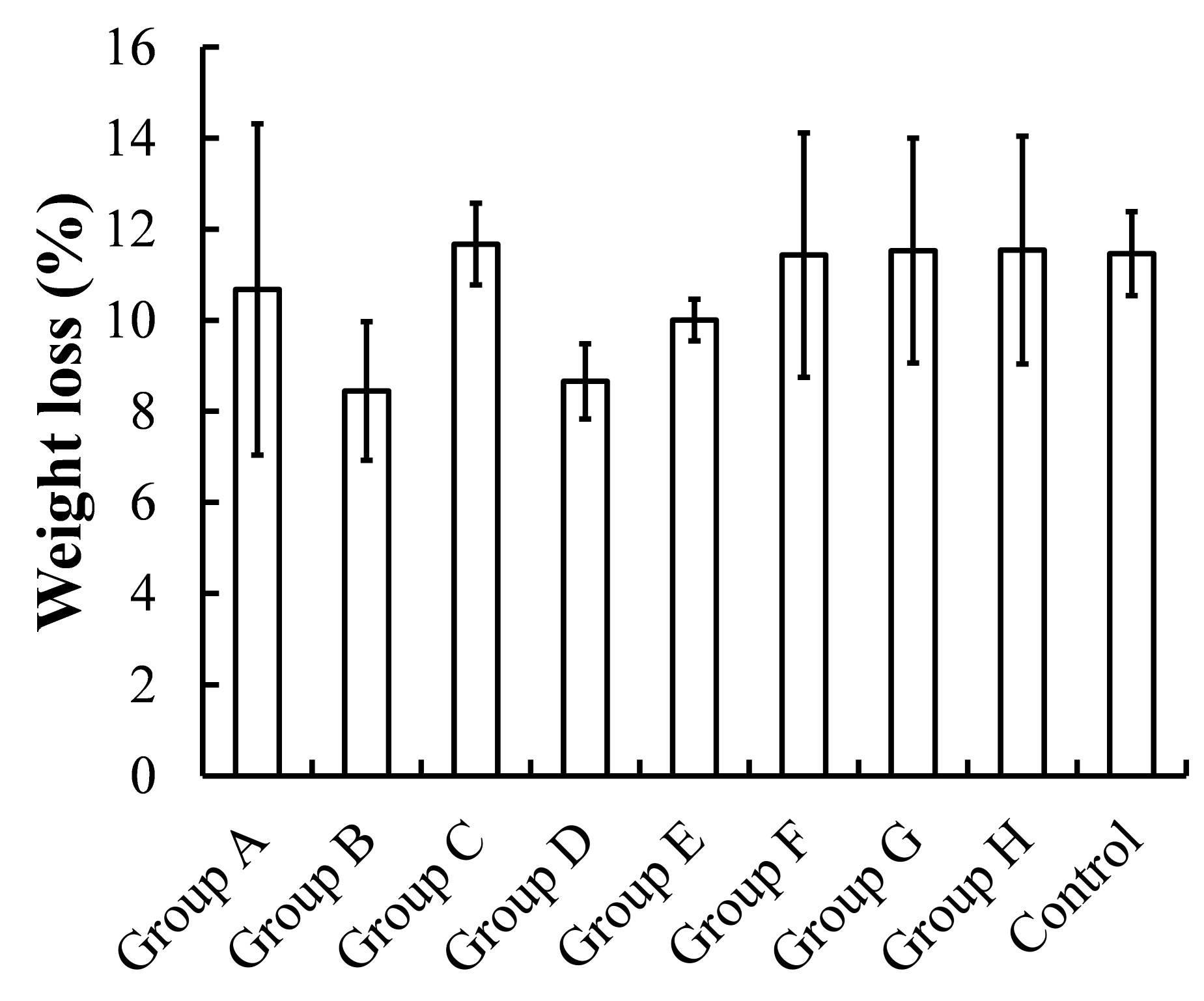
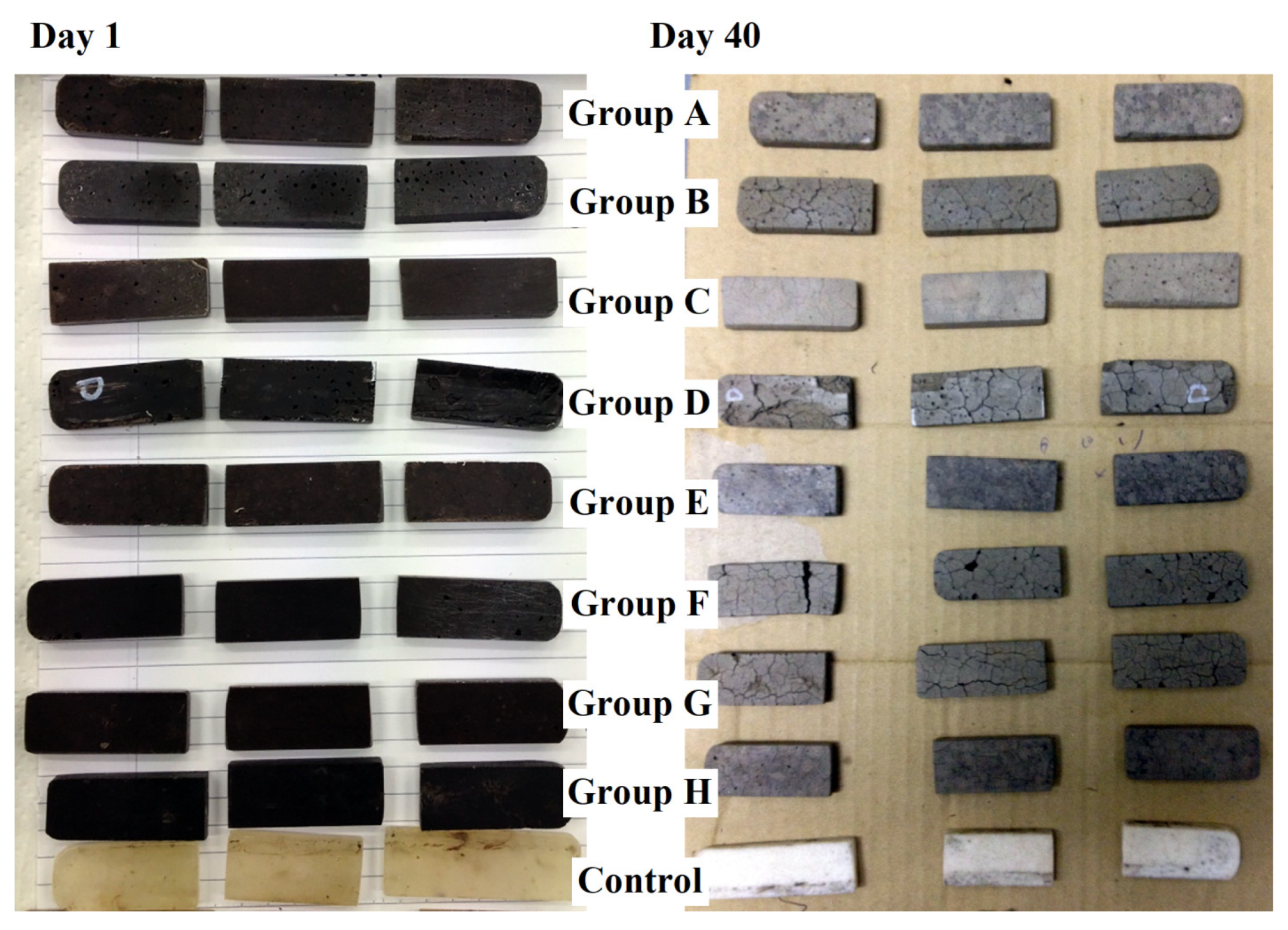
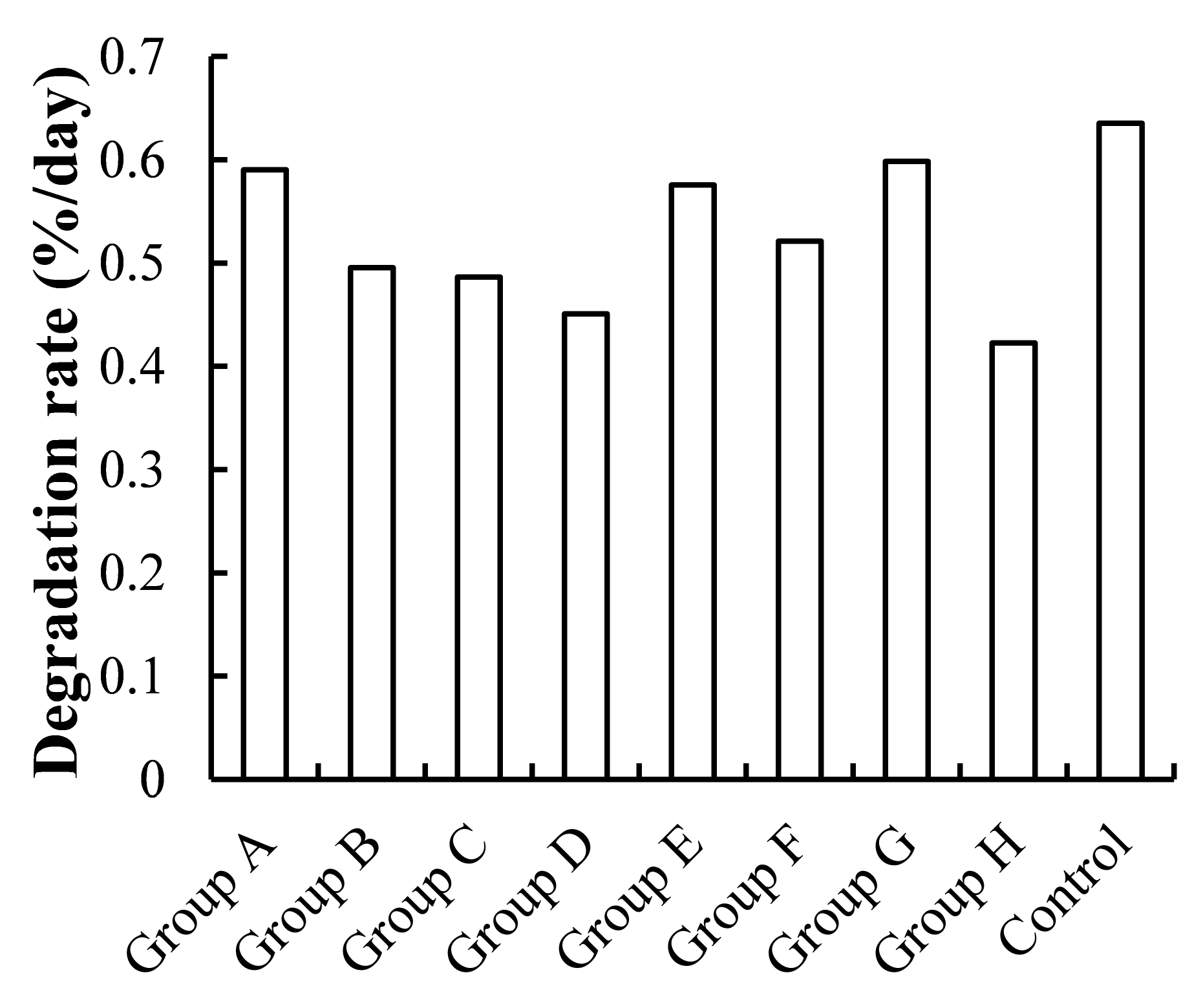

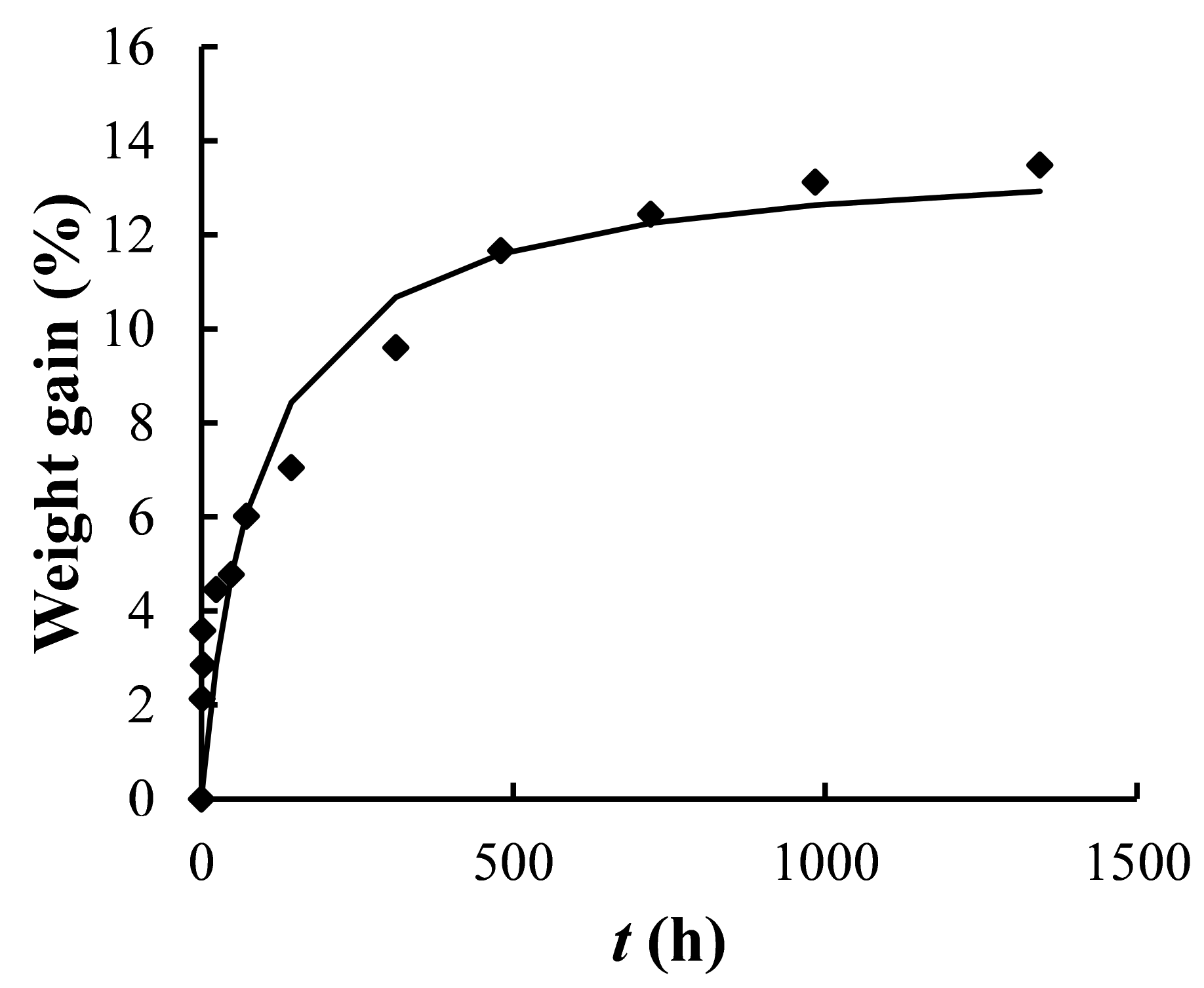
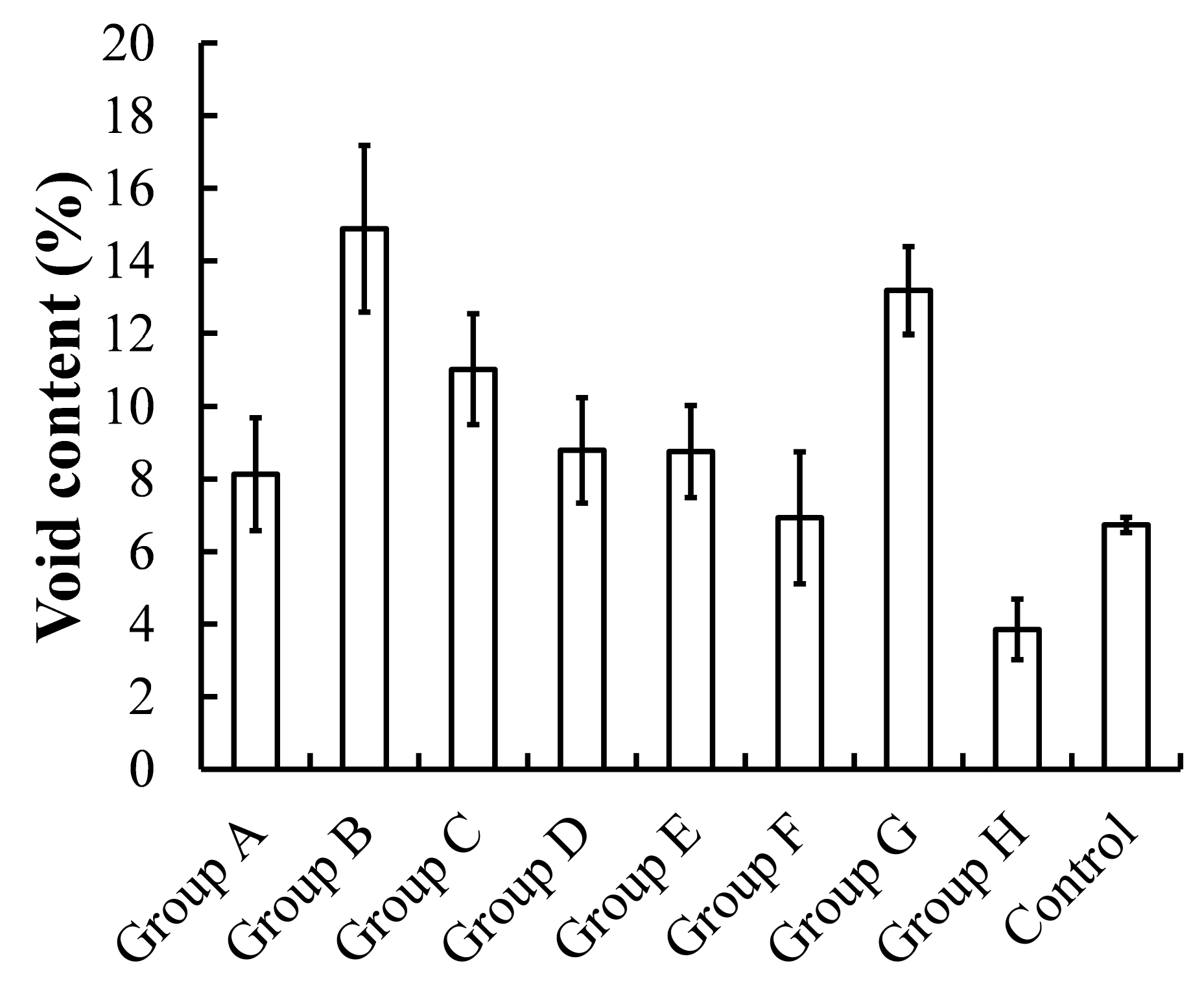
| Constituent | Content (%) | Standard Deviation (%) |
|---|---|---|
| Cellulose | 29.5 | 0.03 |
| Hemicellulose | 30.0 | 2.5 |
| Lignin | 40.1 | 0.15 |
| Ash content | 0.31 | 3.2 |
| Group | Powder Weight Content | Powder Condition | Processing Method |
|---|---|---|---|
| A | 20% | As-received | Counter-rotating |
| B | 40% | As-received | Counter-rotating |
| C | 20% | Dried | Counter-rotating |
| D | 40% | Dried | Counter-rotating |
| E | 20% | As-received | Co-rotating |
| F | 40% | As-received | Co-rotating |
| G | 20% | Dried | Co-rotating |
| H | 40% | Dried | Co-rotating |
| Control | – | – | – |
| Group | k1 | k2 | Ultimate Weight Gain (%) |
|---|---|---|---|
| A | 16.014 | 0.278 | 3.60 |
| B | 6.648 | 0.072 | 13.81 |
| C | 19.824 | 0.128 | 7.84 |
| D | 10.919 | 0.072 | 13.85 |
| E | 16.775 | 0.247 | 4.05 |
| F | 30.066 | 0.065 | 15.36 |
| G | 22.352 | 0.223 | 4.49 |
| H | 16.459 | 0.106 | 9.44 |
| Control | 63.265 | 0.732 | 1.37 |
Disclaimer/Publisher’s Note: The statements, opinions and data contained in all publications are solely those of the individual author(s) and contributor(s) and not of MDPI and/or the editor(s). MDPI and/or the editor(s) disclaim responsibility for any injury to people or property resulting from any ideas, methods, instructions or products referred to in the content. |
© 2024 by the authors. Licensee MDPI, Basel, Switzerland. This article is an open access article distributed under the terms and conditions of the Creative Commons Attribution (CC BY) license (https://creativecommons.org/licenses/by/4.0/).
Share and Cite
Dong, C.; Davies, I.J.; Fornari Junior, C.C.M. Biodegradability and Water Absorption of Macadamia Nutshell Powder-Reinforced Poly(lactic Acid) Biocomposites. Sustainability 2024, 16, 3139. https://doi.org/10.3390/su16083139
Dong C, Davies IJ, Fornari Junior CCM. Biodegradability and Water Absorption of Macadamia Nutshell Powder-Reinforced Poly(lactic Acid) Biocomposites. Sustainability. 2024; 16(8):3139. https://doi.org/10.3390/su16083139
Chicago/Turabian StyleDong, Chensong, Ian J. Davies, and Celso Carlino Maria Fornari Junior. 2024. "Biodegradability and Water Absorption of Macadamia Nutshell Powder-Reinforced Poly(lactic Acid) Biocomposites" Sustainability 16, no. 8: 3139. https://doi.org/10.3390/su16083139
APA StyleDong, C., Davies, I. J., & Fornari Junior, C. C. M. (2024). Biodegradability and Water Absorption of Macadamia Nutshell Powder-Reinforced Poly(lactic Acid) Biocomposites. Sustainability, 16(8), 3139. https://doi.org/10.3390/su16083139








